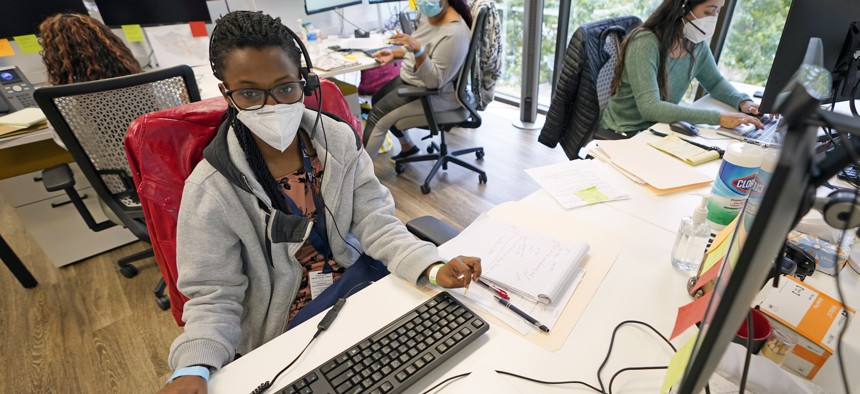Contact Tracing in Two North Carolina Counties Shows Difficulty of Reaching Patients

Contact tracers, from left to right, Christella Uwera, Dishell Freeman and Alejandra Camarillo work at Harris County Public Health contact tracing facility Thursday, June 25, 2020, in Houston. AP Photo/David J. Phillip

Connecting state and local government leaders
The CDC found that in Mecklenburg County, just 77% of patients could be reached after testing positive for Covid-19. Contact information for those peoples’ recent contacts was provided only 52% of the time.
Public health departments across the country hired armies of contact tracers to assist in efforts to contain the spread of covid-19 infections.
But despite aggressive efforts by local departments, tracers have found it difficult to do their jobs—calls are ignored or people don’t want to share details about their recent travels and interactions.
A paper released Tuesday by the Centers for Disease Control and Prevention analyzed contact tracing in two North Carolina counties and found that investigators were unable to conduct any tracing efforts in a significant portion of cases.
In Mecklenburg County, the county health department was able to begin an initial investigation in only 77% of the 7,116 positive coronavirus cases from June 1 through July 12. In 1,602 positive cases, patients did not provide any contact information for themselves or did not respond to phone calls. Of the 5,514 cases in which public health officials could reach the positive patient, 48% of patients did not provide investigators with any of the people they had been in close contact with.
In Randolph County, where 584 cases were investigated during the same time, 35% of patients reported no contacts.
Contact tracing is a containment tool used by public health departments for years to track and prevent the spread of certain types of diseases, from measles to Ebola to sexually transmitted diseases. It requires investigators to track down each person who has come in contact with a contagious person, helping them isolate for a period of time to monitor for symptoms in order to stop the spread of the disease.
Even when patients did report their recent contacts and investigators attempted to track those people down, they were often not able to reach them, according to the CDC findings.
“Among contacts provided, 25% in Mecklenburg and 48% in Randolph could not be reached by telephone and were classified as nonresponsive after at least one attempt on three consecutive days of failed attempts,” the CDC paper states.
Between 2% and 4% of the contacts who were reached opted out of health department monitoring.
The CDC said the contact tracing results are comparable to data reported out of other states, including Maryland and New Jersey, where the 50% and 52% of patients who tested positive for coronavirus provided no contacts.
“The relatively low participation and cooperation with contact tracing suggests a lack of community support and engagement with contact tracing,” the CDC paper states. “This, coupled with delays in testing results, are contributing to ongoing transmission.”
Some health experts have suggested that given the volume of coronavirus infections and the time it takes to receive test results, public health departments should focus more on other efforts to prevent community spread.
“Contact tracing is the wrong tool for the wrong job at the wrong time,” Dr. David Lakey, a former Texas health commissioner, told the New York Times. “Back when you had 10 cases here in Texas, it might have been useful. But if you don’t have rapid testing, it is going to be very difficult in a disease with 40% of people asymptomatic. It is hard to see the benefit of it right now.”
The CDC suggests a number of factors may be affecting the usefulness of contact tracing.
Because tracing is limited to phone calls, rather than in-person interviews, health workers may have a harder time developing rapport with patients, which can result in them divulging information about their contacts and travels. People who test positive for Covid-19 may also not want to subject their contacts to quarantine measures. Health officials recommend anyone exposed to the virus self-quarantine for 14 days. People may also decline to answer phone calls from numbers they do not recognize and may not return health officials’ calls.
To improve contact tracing efforts, the CDC recommends that public health officials reduce the length of time it takes to reach both people who test positive for the virus and their contacts, and also provide more community engagement. To address some of the problems, the CDC noted the North Carolina Department of Health and Human Services hired additional staff members to support local health departments, and has invested in technology to ensure that a single statewide caller identification number is used for text messages and phone calls regarding contact tracing.
Andrea Noble is a staff correspondent with Route Fifty.

NEXT STORY: Decision to Shorten Census Schedule Came From Outside the Census Bureau, Watchdog Says




